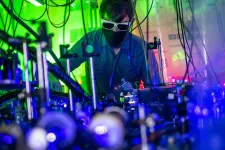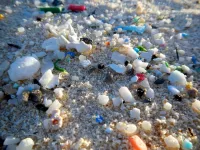How 'great' was the great oxygenation event?
A look at enzyme evolution suggests life figured out how to use oxygen long before the main event
2021-03-01
(Press-News.org) Around 2.5 billion years ago, our planet experienced what was possibly the greatest change in its history: According to the geological record, molecular oxygen suddenly went from nonexistent to becoming freely available everywhere. Evidence for the "great oxygenation event" (GOE) is clearly visible, for example, in banded iron formations containing oxidized iron. The GOE, of course, is what allowed oxygen-using organisms - respirators - and ultimately ourselves, to evolve. But was it indeed a "great event" in the sense that the change was radical and sudden, or were the organisms alive at the time already using free oxygen, just at lower levels?
Prof. Dan Tawfik of the Weizmann Institute of Science's Biomolecular Sciences Department explains that the dating of the GOE is indisputable, as is the fact that the molecular oxygen was produced by photosynthetic microorganisms. Chemically speaking, energy taken from light split water into protons (hydrogen ions) and oxygen. The electrons produced in this process were used to form energy-storing compounds (sugars), and the oxygen, a by-product, was initially released into the surroundings.
The question that has not been resolved, however, is: Did the production of oxygen coincide with the GOE, or did living organisms have access to oxygen even before that event? One side of this debate states that molecular oxygen would not have been available before the GOE, as the chemistry of the atmosphere and oceans prior to that time would have ensured that any oxygen released by photosynthesis would have immediately reacted chemically. A second side of the debate, however, suggests that some of the oxygen produced by the photosynthetic microorganisms may have remained free long enough for non-photosynthetic organisms to snap it up for their own use, even before the GOE. Several conjectures in between these two have proposed "oases," or short-lived "waves," of atmospheric oxygenation.
Research student Jagoda Jabłońska in Tawfik's group thought that the group's focus - protein evolution - could help resolve the issue. That is, using methods of tracing how and when various proteins have evolved, she and Tawfik might find out when living organisms began to process oxygen. Such phylogenetic trees are widely used to unravel the history of species, or human families, but also of protein families, and Jabłońska decided to use a similar approach to unearth the evolution of oxygen-based enzymes.
To begin the study, Jabłońska sorted through around 130 known families of enzymes that either make or use oxygen in bacteria and archaea - the sorts of life forms that would have been around in the Archean Eon (the period between the emergence of life, ca. 4 billion years ago, and the GOE). From these she selected around half, in which oxygen-using or -emitting activity was found in most or all of the family members and seemed to be the founding function. That is, the very first family member would have emerged as an oxygen enzyme. From these, she selected 36 whose evolutionary history could be traced conclusively. "Of course, it was far from simple," says Tawfik. "Genes can be lost in some organisms, giving the impression they evolved later in members in which they held on. And microorganisms share genes horizontally, messing up the phylogenetic trees and leading to an overestimation of the enzyme's age. We had to correct for the latter, especially."
The phylogenetic trees the researchers ultimately obtained showed a burst of oxygen-based enzyme evolution about 3 billion years ago - something like half a billion years before the GOE. Examining this time frame further, the scientists found that rather than coinciding with the takeover of atmospheric oxygen, this burst dated to the time that bacteria left the oceans and began to colonize the land. A few oxygen-using enzymes could be traced back even farther. If oxygen use had coincided with the GOE, the enzymes that use it would have evolved later, so the findings supported the scenario in which oxygen was already known to many life forms by the time the GOE took place.
The scenario that Jabłońska and Tawfik propose looks something like this: Oxygen is one of the most chemically reactive elements around. Like one end of a battery, it readily accepts electrons, thus providing extra metabolic power. That makes it extremely useful to many life forms, but also potentially damaging. So photosynthetic organisms as well as other organisms living in their vicinity had to quickly develop ways to efficiently dispose of oxygen. This would account for the emergence of oxygen-utilizing enzymes that would remove molecular oxygen from cells. One microorganism's waste, however, is another's potential source of life. Oxygen's unique reactivity enabled organisms to break down and use "resilient" molecules such as aromatics and lipids, so enzymes that take up and use oxygen likely began evolving soon after.
Tawfik: "This confirms the hypothesis that oxygen appeared and persisted in the biosphere well before the GOE. It took time to achieve the higher GOE level, but by then oxygen was widely known in the biosphere."
Jabłońska: "Our research presents a completely new means of dating oxygen emergence, and one that helps us understand how life as we know it now evolved."
INFORMATION:
Prof. Dan Tawfik's research is supported by the Zuckerman STEM Leadership Program. Prof. Tawfik is the incumbent of the Nella and Leon Benoziyo Professorial Chair.
ELSE PRESS RELEASES FROM THIS DATE:
2021-03-01
HOUSTON - (March 1, 2021) - Rice University physicists have discovered a way to trap the world's coldest plasma in a magnetic bottle, a technological achievement that could advance research into clean energy, space weather and astrophysics.
"To understand how the solar wind interacts with the Earth, or to generate clean energy from nuclear fusion, one has to understand how plasma -- a soup of electrons and ions -- behaves in a magnetic field," said Rice Dean of Natural Sciences Tom Killian, the corresponding author of a published study about the work in Physical Review Letters.
Using laser-cooled strontium, ...
2021-03-01
Europeans spend more than £700 billion (€800bn) a year on recreational visits to water bodies - but perceived poor water quality costs almost £90 billion (€100bn) in lost visits, a new study has found.
The new research - led by a European collaboration involving the University of Exeter and the University of Stirling - used data from 11,000 visits in 14 different countries to analyse the economic value of water bodies, such as rivers, lakes, waterfalls, beaches and seaside promenades.
The research team estimated that people spend an average of £35 (€40) travelling to and from these sites, with a typical family making 45 such trips each year.
The team also found ...
2021-03-01
Rutgers scientists for the first time have pinpointed the sizes of microplastics from a highly urbanized estuarine and coastal system with numerous sources of fresh water, including the Hudson River and Raritan River.
Their study of tiny pieces of plastic in the Hudson-Raritan Estuary in New Jersey and New York indicates that stormwater could be an important source of the plastic pollution that plagues oceans, bays, rivers and other waters and threatens aquatic and other life.
"Stormwater, an understudied pathway for microplastics to enter waterways, had similar or higher concentrations of ...
2021-03-01
DALLAS, March 1, 2021 — Studies representing nearly 2 million adults worldwide show that eating about five daily servings of fruits and vegetables, in which 2 are fruits and 3 are vegetables, is likely the optimal amount for a longer life, according to new research published today in the American Heart Association’s flagship journal Circulation.
Diets rich in fruits and vegetables help reduce risk for numerous chronic health conditions that are leading causes of death, including cardiovascular disease and cancer. Yet, only about one in 10 adults eat enough fruits or vegetables, according to the U.S. Centers for Disease Control and Prevention.
“While groups like the ...
2021-03-01
A new method, described in a study published today in the journal Nature Communications, has the potential to boost international research efforts to find drugs that eradicate cancer at its source.
Most cancerous tissue consists of rapidly dividing cells with a limited capacity for self-renewal, meaning that the bulk of cells stop reproducing after a certain number of divisions. However, cancer stem cells can replicate indefinitely, fuelling long-term cancer growth and driving relapse.
Cancer stem cells that elude conventional treatments like chemotherapy are one of the reasons ...
2021-03-01
With eight months to go before the UN Climate Change Conference (COP26), an international survey experiment has found evidence of "overwhelming" support across seven major countries for governments to "do more" to protect the environment.
The survey directly asks the public about policies they want to see backed by governments at COP26, when the UK and Italy will gather world leaders in Glasgow from 1 November to commit to urgent global climate action.
Researchers at the University of Cambridge worked with polling agency YouGov on a message-testing experiment involving 14,627 adults, with ...
2021-03-01
Diversity, equity and inclusion (DEI) leaders in academic medicine are subject to increasing expectations with limited resources and there is an urgent need for psychiatry departments to commit to fully supporting their efforts, according to an article now available in the American Journal of Psychiatry written by top DEI leaders in academic psychiatry from across the country.
The authors, representing prominent public and private institutions, include Ayana Jordan, M.D., Ph.D., Yale University, and current APA ECP Trustee-at-Large; Ruth S. Shim, M.D., M.P.H. University ...
2021-03-01
BINGHAMTON, NY - Several proposals have emerged on how to distribute the COVID-19 vaccine, but they fall short in ensuring that the vaccine is distributed fairly. A team including Binghamton University professor Nicole Hassoun suggests three ways to more fairly and effectively distribute the vaccine so that people in poor countries get the vaccine as soon as possible.
"Although many people in rich countries will receive a vaccine for COVID-19 this year, many people in poor countries will likely have to wait years to get one," said Hassoun. "Ethical vaccine allocation requires closing this gap and ensuring that everyone can access a vaccine ...
2021-03-01
PHILADELPHIA-- Hospital emergency departments (EDs) not only care for patients with overdose and other complications from opioid use, but they also serve as vital touch points to engage patients into longer-term treatment. After an overdose, patients are at risk for repeat overdose and death. Pennsylvania is unique in establishing a voluntary incentive program to improve the rate at which patients with opioid use disorder receive follow-up treatment after emergency department care. Evaluations of the program show that financial incentives are effective in producing rapid treatment innovations for opioid use disorder.
In a study, researchers at the Perelman School of Medicine at ...
2021-03-01
Oak Brook, IL - The March edition of SLAS Discovery features the cover article, "Therapeutic and Vaccine Options for COVID-19: Status After 6 Months of the Disease Outbreak" by Christian Ogaugwu (Federal University Oye-Ekiti, Ekiti State, Nigeria ), Dawid Maciorowski, Subba Rao Durvasula, Ph.D., Ravi Durvasula, M.D., and Adinarayana Kunamneni, Ph.D. (Loyola University Medical Center, Maywood, IL, USA).
This cover article focuses on the therapeutic and vaccine options available against the novel coronavirus, roughly six months after the outbreak; because the COVID-19-related death toll worldwide had reached 500,000 in six months (and ballooned to over 2,000,000 at the time of publishing) the importance of options to temper the disease cannot be overemphasized. The article ...
LAST 30 PRESS RELEASES:
[Press-News.org] How 'great' was the great oxygenation event?
A look at enzyme evolution suggests life figured out how to use oxygen long before the main event


